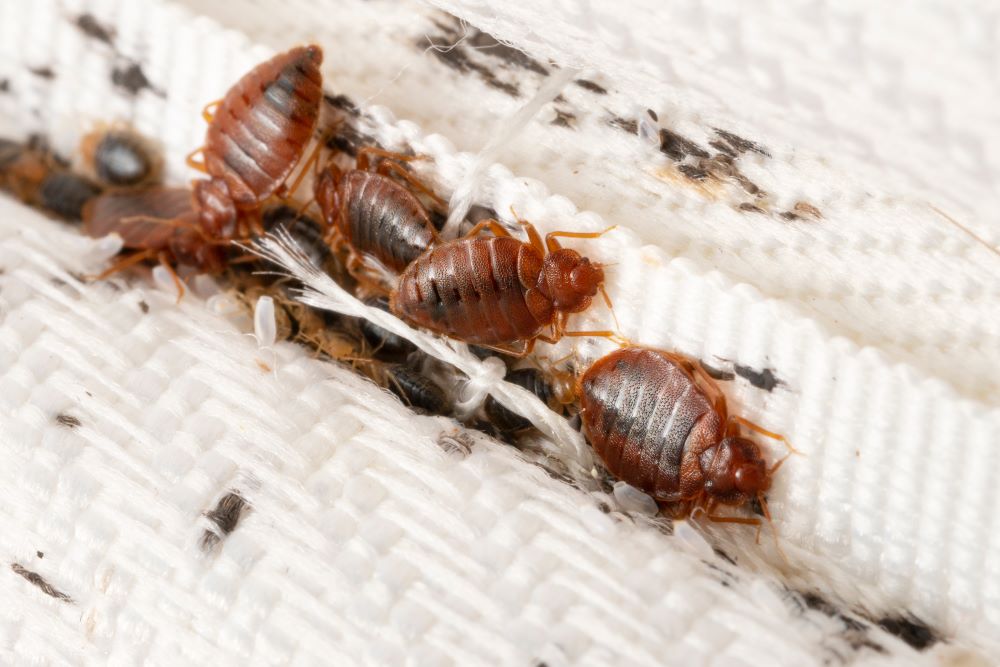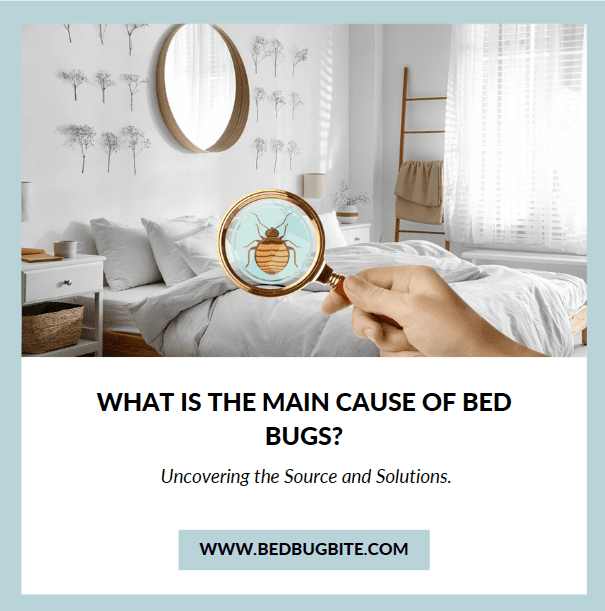Introduction
Bed bugs are small, elusive insects that have become a widespread concern for homeowners, travelers, and even businesses. Understanding what bed bugs are, and more importantly, what causes them, is essential for both prevention and eradication. These parasites, known scientifically as Cimex lectularius, thrive in various environments where people live and sleep.
According to the Centers for Disease Control and Prevention (CDC), bed bugs are not merely a nuisance but can cause allergic reactions in some individuals. A comprehensive insight into the main causes of bed bug infestations not only helps in understanding how these pests can invade our lives but also aids in devising effective strategies to combat them.
In this detailed guide, we will explore the root causes of bed bug infestations, focusing on factors like travel, second-hand items, poor sanitation, and more. Our goal is to equip you with the knowledge and tools you need to understand these pests and how to keep them at bay. By delving into the biology, myths, real-life case studies, and proven solutions, we present a holistic approach to a problem that has troubled humanity for centuries. Whether you are facing a current bed bug issue or seeking ways to prevent one in the future, this article will provide you with the information and guidance you need.
Understanding Bed Bug Biology
A profound understanding of bed bug biology is pivotal to grasping why these insects infest areas and how to counteract their presence. These small, wingless insects are mainly nocturnal, and their unique biology plays a significant role in their survival.

Life Cycle of Bed Bugs: Bed bugs undergo a fascinating yet disturbing life cycle comprising five nymph stages and an adult stage. During each nymph stage, they require at least one blood meal to mature, generally feeding on human hosts but sometimes on animals. They can mature in as little as a month, and females lay hundreds of eggs over their lifetime.
Habitats and Preferences: Bed bugs are adaptable and can be found in a variety of places, from homes and hotels to public transportation. They prefer proximity to human sleeping areas and often hide in mattresses, furniture, and crevices during the daytime.
Feeding Habits and Human Interaction: The feeding habits of bed bugs are closely tied to human interaction. According to a study by the University of Kentucky College of Agriculture, Food and Environment, bed bugs feed by piercing the skin and withdrawing blood through an elongated beak. The feeding can take anywhere from 3 to 10 minutes and often goes unnoticed by the host. They are not known to transmit diseases, but their bites can lead to itching, discomfort, and in some cases, severe allergic reactions.
What is The Main Cause of Bed Bug Infestation:
Understanding what drives the presence of bed bugs in various environments is crucial for effective prevention and eradication. These underlying causes are diverse and are often linked to human activity. Let’s explore the main factors contributing to bed bug infestations:
Travel and Transportation

- Luggage, Furniture, and Clothing: Bed bugs can easily hitchhike in personal belongings, including suitcases, purses, and clothing. Whether in airports or train stations, they find ways to travel from one location to another.
- Public Transportation: Infestations can occur in buses, trains, and cabs where bed bugs can migrate from person to person, laying their groundwork for a broader infestation.
- Hotels and Accommodation: Even five-star hotels are not immune to bed bugs. They can reside in mattresses, furniture, and other hiding spots, waiting for an opportunity to travel with unsuspecting guests.
- In apartment complexes and other multi-unit dwellings, bed bugs can easily move between units through cracks in walls, electrical outlets, and plumbing. An infestation in one apartment can quickly spread to neighboring units.
Second-hand Items
- Furniture: Purchasing second-hand furniture without a thorough inspection can introduce bed bugs into a home.
- Clothing and Fabrics: Thrift stores and yard sales may harbor these insects in used garments, curtains, or bedding. A detailed guide on how to inspect for bed bugs in second-hand items is a must for anyone shopping used.
Poor Sanitation and Living Conditions
- Urban Infestations: Crowded urban areas with shared living spaces can create ideal conditions for bed bugs to spread.
- Lack of Regular Cleaning: Neglecting regular cleaning and maintenance can allow bed bugs to thrive unnoticed.
- Connection to Other Pests: While not solely due to poor sanitation, the presence of other pests may indicate a vulnerability to bed bug infestations.
According to the Environmental Protection Agency (EPA), these causes are not limited to residential areas but can affect various public places. Recognizing these common avenues of infestation forms the bedrock of effective prevention and treatment strategies.
How Bed Bugs Spread
The spreading of bed bugs is a complex phenomenon driven by both their biological characteristics and human activities. Understanding how bed bugs spread is fundamental to implementing measures that can prevent or contain an infestation. Here’s an in-depth look at how these pests propagate:
Person-to-Person Contact
Bed bugs can easily transfer between people in crowded places such as public transportation or communal living areas. Items like clothing, luggage, or furniture that move between households can carry bed bugs from one place to another. Friends, family, or other visitors who have been in an infested environment might unintentionally bring bed bugs into your home on their clothing or belongings. Although uncommon, bed bugs can also be transported by animals like bats and birds. This is typically more prevalent in certain geographical regions. Failing to recognize the signs of bed bugs or not knowing how to respond can lead to infestations going untreated, allowing the bed bugs to multiply, and spread.
In apartments, hotels, or dormitories, bed bugs can travel through cracks, walls, and shared utilities, infecting multiple units. In shared laundry areas, bed bugs can travel from infested clothing or linens to other garments, leading to the spread of the infestation. Even professional environments are not exempt, as bed bugs can find their way into offices through personal belongings.
Bed bug infestations can be a severe and stressful problem for homeowners, renters, and travelers alike. Understanding the main causes of bed bug infestations can help in implementing preventive measures.
Prevention and Control Measures:
Regular inspections of living spaces, luggage, and belongings can identify and isolate bed bugs before they spread. If you suspect an infestation, consulting a professional exterminator can provide targeted solutions to halt the spread.
Utilize a high-quality protective mattress cover to create a barrier that bed bugs cannot penetrate. When traveling, it’s crucial to inspect hotel rooms and keep your luggage off the floor, as bed bugs can hitch a ride back to your home. When returning from a trip, unpack luggage outside or in a contained area like a garage, and wash all travel clothing promptly.

Regularly washing and drying your linens on high heat is another effective way to kill any bed bugs. In multi-unit buildings, coordinating with neighbors and property management to conduct regular inspections and treatments can prevent bed bugs from moving between units.
Utilizing bed bug monitors or traps near beds and furniture can help detect their presence early before they become a more significant issue. Regularly vacuuming carpets, rugs, and upholstered furniture can remove bed bugs and their eggs. Remember to properly dispose of the vacuum bag or clean the container immediately to prevent them from escaping. If you suspect an item is infested, promptly seal it in a plastic bag and treat it appropriately. If it cannot be treated, dispose of it securely to prevent the bed bugs from spreading.
Professional and DIY Solutions
Addressing a bed bug infestation requires both expertise and action. Whether you choose to take on the problem yourself or seek professional assistance, understanding the available options is essential. Below is a detailed guide on professional and DIY solutions to tackle bed bug infestations.
Professional Extermination Methods
- Heat Treatment: Utilizing high temperatures to eradicate bed bugs is a proven method. Professionals use specialized equipment to heat the infested area to levels that bed bugs cannot survive.
- Chemical Treatment: Exterminators may apply approved pesticides, carefully targeting the infestation without harming humans or pets.
- Consulting Reputable Exterminators: Reaching out to experienced professionals, such as those listed by the National Pest Management Association, guarantees thorough and safe elimination.
Home Remedies and DIY Solutions
- Cleaning and Vacuuming: Regular cleaning and vacuuming of mattresses, furniture, and affected areas can reduce the bed bug population.
- Steam Cleaning: Using a high-temperature steam cleaner can kill bed bugs in various life stages.
- Using Bed Bug Traps: Commercially available traps or DIY solutions can isolate and reduce bed bug numbers.
- Consulting Reliable Guides: Before attempting DIY solutions, consult reputable guides.
Bed bugs can be a challenging pest to control, but a combination of professional and DIY solutions offers a roadmap to a bed bug-free life. By understanding the methods available, their effectiveness, and how to implement them, you’re empowered to take action that suits your situation. Always consult professionals or reliable sources when unsure, as incorrect treatment can worsen the infestation.
Myths and Misconceptions about Bed Bugs
In the complex world of bed bug control, misinformation can lead to ineffective strategies and prolonged suffering. Understanding the truth behind common myths is crucial for effective bed bug management. Here we debunk some widely held misconceptions and offer factual insights:
Debunking Common Myths
- Myth: Bed Bugs Transmit Diseases: Despite their unsettling presence, bed bugs are not known to transmit diseases to humans. Their bites may cause itching and discomfort, but no evidence links them to disease transmission.
- Myth: Bed Bugs Are a Sign of Poor Hygiene: Bed bugs can infest even the cleanest environments. They are attracted to the carbon dioxide humans exhale and the warmth of the human body, not dirt or grime.
- Myth: Bed Bugs Only Live in Beds: Though commonly found in mattresses, bed bugs can reside in furniture, carpets, and even electrical outlets.
Clarifying Misunderstandings
Fact: Bed Bugs Can Survive Without Feeding for Months: Contrary to belief, bed bugs can live without a blood meal for several months, depending on the temperature and humidity.
Fact: DIY Methods Are Not Always Effective: Many home remedies are ineffective or may even spread the infestation.
Case Studies and Success Stories
The journey to understanding and eradicating bed bugs can be illustrated best through real-life experiences. These case studies and success stories not only provide practical insights but also instill confidence in those facing similar challenges. Here’s an in-depth look at some notable examples:
Real-life Examples of Infestations and Solutions
- A Family Home Overrun by Bed Bugs: A suburban family discovered an infestation that spread rapidly throughout their home. With professional help, including heat treatment and regular monitoring, they managed to eradicate the bed bugs within a few weeks.
- A Hotel’s Battle with Persistent Bed Bugs: A reputable hotel faced recurring bed bug problems despite repeated treatments. An extensive inspection revealed hidden infestations within the building’s structure. With a combination of professional methods, they achieved a bed bug-free environment.
- An Apartment Complex’s Comprehensive Approach: An apartment complex experienced widespread infestation. Through collaboration with residents and professional exterminators, a combination of chemical treatments and preventive measures led to success.
Lessons Learned
- The Importance of Timely Action: Prompt recognition and action can prevent a minor issue from becoming a significant problem.
- The Value of Professional Expertise: Expert guidance can be vital in complex situations.
- Understanding the Complexity of Bed Bug Behavior: Bed bugs’ ability to hide in unexpected places makes a thorough understanding and inspection essential.
How Expert Knowledge Can Make a Difference

- Informed Decision-making: Expert knowledge empowers individuals and businesses to make the right choices in treating infestations.
- Customized Solutions: Different situations require different solutions; understanding bed bugs allows for targeted and effective treatments.
- Building a Bed Bug-Free Future: Continuous learning, preventive measures, and professional guidance build resilience against future infestations.
The stories shared here are more than mere anecdotes; they are illustrative lessons, testaments to the complexities of bed bug behavior, and the effectiveness of informed actions. These real-life experiences shed light on the multifaceted nature of bed bug control, emphasizing the importance of a comprehensive approach. Readers gain actionable insights and encouragement by learning from these cases, knowing that they can overcome even the most daunting bed bug problems with the right knowledge and resources.
In Summary
Bed bugs are a prevalent issue that can affect anyone, regardless of location or living conditions. As we’ve explored through this comprehensive guide, understanding the main causes of bed bugs is the first step toward effective eradication.
Summary of Main Causes
- Travel and Transportation: Movement of luggage, furniture, and clothing are common causes.
- Second-hand Items: Infested furniture or fabrics can lead to a new infestation.
- Poor Sanitation and Living Conditions: While not solely responsible, these factors can contribute.
These causes underscore the complex nature of bed bugs, showing that they are not confined to any specific environment.
Reiteration of Solutions
- Professional and DIY Solutions: Both approaches have their merits and can be applied based on the situation’s complexity.
- Prevention Techniques and Regular Maintenance: Proactive measures can significantly reduce the risk of infestation.
By employing the right methods and continuous vigilance, you can create a bed bug-free space.
Encouragement to Seek Professional Help if Needed.
– If the situation appears overwhelming, don’t hesitate to consult a professional. Expert assistance can ensure the complete eradication of bed bugs.
Final Thoughts and Call to Action for Reader Engagement
The battle against bed bugs is both challenging and solvable. The knowledge and insights shared in this guide better equip you to recognize, confront, and conquer any bed bug issues.
Have you dealt with bed bugs? Share your experiences and thoughts in the comments below, and let’s continue the conversation!
In the quest to understand and combat bed bugs, information is your strongest ally. This comprehensive guide has illuminated the main causes and provided actionable solutions, debunked myths, and offered real-life success stories. Whether you’re facing a current infestation or seeking preventive knowledge, these insights empower you to tackle bed bug problems effectively and confidently. Together, we can build a bed bug-free future!




